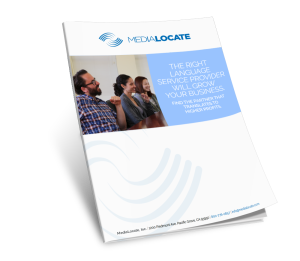
Industry analysts estimate over 20,000 language service providers (LSPs) across the world. With so many options, how do you differentiate between them? How do you know which LSP will best meet your needs? One way is to evaluate the maturity of your LSP. Here are 7 questions you can ask your LSP to determine if they will be able to succeed with your project.
1. “What is your process for handling non-conforming translations?” 
No LSP is perfect. What differentiates an LSP is how it handles imperfection. An immature LSP will have trouble describing their process for handling non-conformances, whereas a mature LSP may respond with a description of their procedure quoted from their quality assurance manual. An LSP that maintains any of the following certifications follows a documented set of processes that will ensure quality:
- ISO 9001
- ISO 17100
- EN 15038
2. “What differentiates your translation services from others?” 
Pay attention to how an LSP answers this question. An immature LSP will tend to compare themselves with even less mature LSPs by answering “quality.” But let’s face it – quality isn’t a differentiator, it’s a necessity to stay in business. Instead of looking for an LSP that can’t stop talking about how much better they are than Google Translate (big surprise), look for one that positions themselves to meet your company’s needs. Listen for phrases like “dedicated account management” or “strategic partnership.”
3. “How do you use your translation management system (TMS)?” 
As an LSP grows, the quantity of projects goes up while the size of projects goes down. To help with this, LSPs adopt translation management systems (TMS) to automate repetitive tasks. A mature LSP will have fully integrated a TMS into their business processes. Buyers of translation services typically have two concerns when it comes to their vendors implementing such technology, but there should really be no reason for concern.
-
- Some buyers are concerned that their LSP’s TMS decreases the level of human interaction. Consider how many emails you’ve sent of this type: “Could you please translate and proofread the following documents into French, Italian, German and Spanish by next week?” A TMS system automates translation requests so you can spend more time having meaningful conversations with your LSP like “How can we make our turnaround time even quicker?”
- Some buyers are concerned that the LSP’s TMS is going to negatively impact linguistic quality. It’s important to note that a TMS does not make linguistic choices. It streamlines project management, organizes linguistic resources like translation memory and terminology, and allows the linguist to have full linguistic control. In fact, using a TMS improves project quality overall, as touch points with a chance for human error are reduced.
4. “How do you handle production and billing for agile projects?” 
Up until now, the translation industry has mainly used the waterfall production method to execute projects. This means that before a piece of content was localized, it had to be complete, passing all previous steps of production. The agile production model, on the other hand may cycle a piece of content through all the production steps multiple times. This allows an agile product like an app to quickly acquire basic working functionality and consistently improve with each iteration. This means that an agile project may send numerous content “drops” for localization throughout the course of product development. These drops typically have a low word count, and they may happen quite frequently, even on a daily basis.
This model challenges LSPs who rely on the waterfall model. Should the LSP bill a minimum charge for each drop? How should the LSP reconcile the small word volume with the costs of constantly managing dozens of little projects? An immature LSP will have trouble defining a customized service offering for your needs, whereas a mature LSP will be happy to offer a customized service offering based on a certain number of drops per month, paid for by a monthly subscription. Look for an LSP that is willing to consider custom service packages and billing models for your project.
5. “What is the background of your employees?” 
Nearly everyone who works at an LSP has one thing in common – a love for languages. Many in the industry come from multi-lingual, international backgrounds. But a love of language alone won’t guarantee success on your project. Localization is a combined effort of not only language specialists, but also experienced business people and skilled engineers. Oftentimes, the best management and engineering talent comes from outside the language industry. A mature LSP employs the best talent wherever it is found. Pay attention to the profiles and background of the company’s management and engineering team.
6. “What other services do you provide besides translation?” 
As a content creator, you have many types of content – marketing materials, documentation, web content, videos, user-generated content, knowledge base and support articles – even internal communications. Translation is not a one-size-fits-all service. Mature LSPs have developed a comprehensive service portfolio to meet the needs of your entire company’s content creators. Here are a couple services you may want to consider:
- Transcreation. When you have a nuanced marketing message and a word-for-word translation won’t do, consider transcreation to represent the idea of the source in a way that will resonate with your target audience.
- Automated Translation. Consider your knowledge base and support articles. Your budget can’t justify translating this vast pool of content by traditional means. Your users want just enough information to guide them through technical issues with your product. Consider automated translation to achieve a level of quality appropriate for the content while at the same time reducing your costs and time-to-market.
- Multimedia. We “buy” with our senses, not with our wallets. So whether you are pitching a product, a service or even your latest and greatest idea, consider taking the multimedia approach. The right video and audio can truly make your message pop, and a sophisticated, multilingual, multicultural campaign will show that you are truly a “cut” above the rest.
- Global Legal Support. Can your partner provide support with international regulatory compliance, warranty regulation, product liability, privacy laws and data security? How about global legal counsel, including advice on licensing agreements, trademark registration, IP protection and transfers, and global M&A compliance?
7. “Do you offer any content connectors or API integrations?” 
Are you copy-pasting content into Word documents or Excel spreadsheets for translation? If so, you may consider using a content connector or API to skip this tedious work. Ask your LSP what kinds of connectors they use, and if they are willing to develop one for your content management system. A mature LSP will be more than willing to save you from the tedious copy-paste work by developing a custom localization solution for you with content connectors.
Choosing a localization partner can be a daunting task. These 7 questions can be a great starting point for evaluating the maturity of your localization partner. What other questions would you add to the list?
Click here for your Guide to Finding the Right Language Services Partner
In this free guide, you’ll gather the important insights you need to make a smart decision and avoid the pains that come with making a bad choice.












